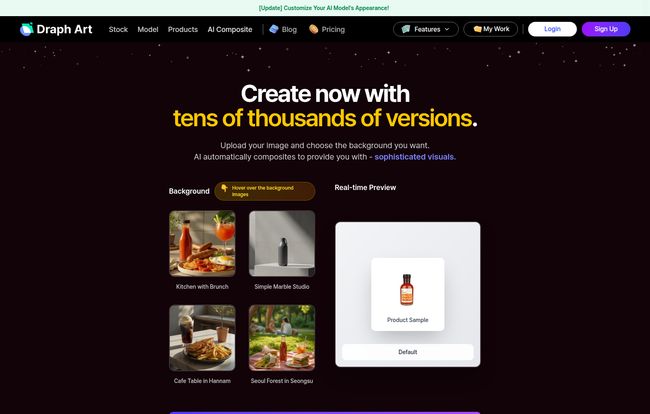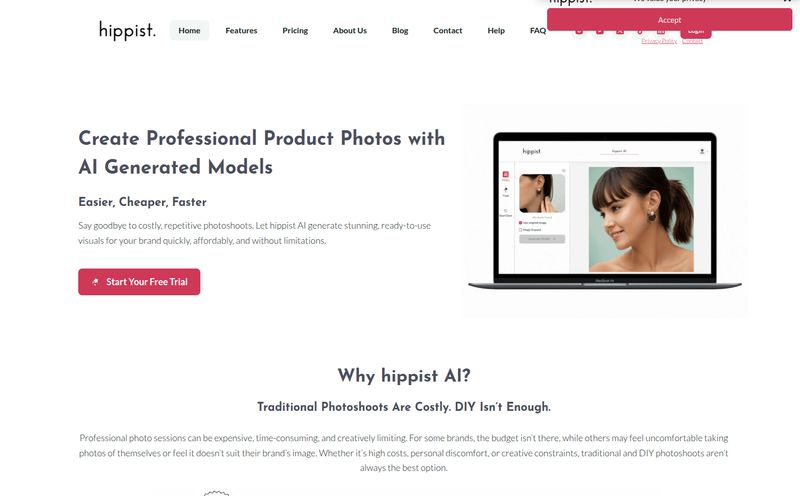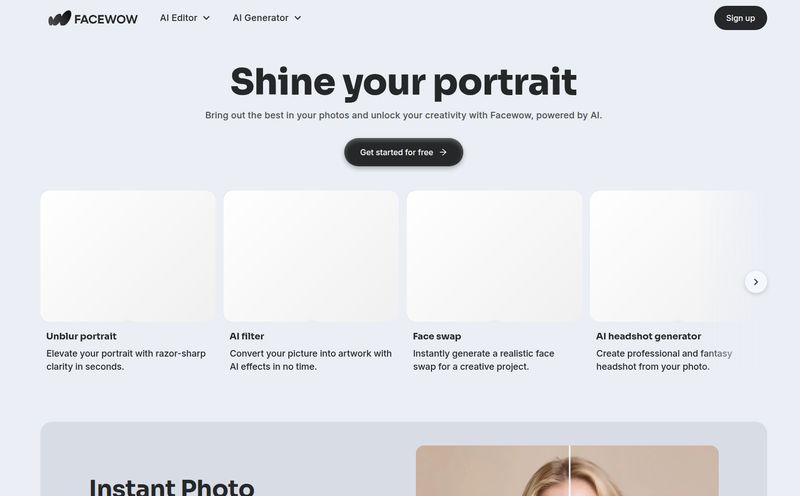I've been in the SEO and traffic generation game for a long time. Long enough to remember when getting a decent product photo meant one of two things: shelling out a small fortune for a professional photographer and studio time, or spending a miserable weekend in my garage with a white sheet, some clunky lamps, and a camera I barely knew how to use. The results of the latter... well, let's just say they usually looked exactly like they were shot in a garage.
We’ve all seen them. The slightly-off-white backgrounds, the weird shadows, the product looking a little… sad. And in the world of e-commerce, a sad-looking product photo is a conversion killer. Full stop.
So when I started seeing tools like Draph Art pop up, my interest was definitely piqued. Another AI tool promising to solve all our problems? Color me skeptical but intrigued. The claim is simple: generate high-quality, professional-looking product images automatically. No photographer, no studio, no garage-based shenanigans. Just you, your product, and an algorithm. But does it actually work?
So, What Exactly is Draph Art?
Let’s cut through the jargon. Draph Art is an AI platform designed to create product images. You upload a picture of your product—ideally a clean shot, but more on that later—and the platform does the heavy lifting. It removes the background and then, this is the cool part, it intelligently places your product into a whole new scene.
We’re not just talking about a simple background swap. The AI generates everything: appropriate props, realistic lighting, natural shadows, and it even gives you options for different settings. The home page shows examples like a bottle of something placed in a “Kitchen with Brunch” or a “Cafe Table in Hannam.” That last one caught my eye—the company is based in Seoul, and that little specific, local touch feels authentic. It’s not just “generic cafe,” it’s a specific vibe they're selling.

Visit Draph Art
How It's Shifting the E-commerce Workflow
The traditional product photography process is a whole thing. It’s a chain of logistics that can be a real drag on a marketing team’s timeline and budget. Draph Art basically takes that entire chain and collapses it into a single step. It's like having a world-class photography studio, a props master, and a lighting technician all living inside a browser tab.
The AI Compositing is Kind of Magic
The core technology here is the AI composite feature. When you drop your product in, the AI isn't just cutting and pasting. It analyzes the new background and your product to figure out how they should interact. If you place your bottle on a marble table, it generates the correct reflection. If the scene has a window on the left, it creates soft shadows on the right. It’s this attention to the small details that separates a good tool from a gimmick. The results are pretty impressive, its almost like a digital magic trick that can seriously boost your conversion rates.
More Than Just a Pretty Background
And it goes deeper. The platform can generate props to make the scene feel more lived-in and real. Selling a skincare product? The AI might add a neatly folded towel or a sprig of lavender next to it. It can even generate AI models to hold or interact with your product, which is a massive cost-saver compared to hiring real people. This is huge for creating lifestyle shots that help customers envision the product in their own lives.
The Good, The Bad, and The AI
Alright, let's get down to brass tacks. No tool is perfect, and it’s my job to see both sides of the coin. After playing around with it and thinking about its real-world applications for my clients, here’s my take.
Where Draph Art Really Delivers
The upsides are obvious and powerful. The first is speed. You can go from a simple product shot to dozens of high-quality, market-ready images in minutes, not weeks. For a startup launching a new product line or an e-commerce store needing fresh social media content, this is a lifesaver. The second is cost. The expense of a single traditional photoshoot can run into the thousands. Draph Art offers a way to get a massive volume of creative assets for what I assume is a fraction of that cost. It’s also incredibly easy to use. The interface seems designed for marketers and entrepreneurs, not necessarily graphic designers.
Some Potential Hurdles to Consider
Now, for the other side. Some people might argue that relying on AI stifles true creativity, and I get that. You are, to some extent, limited by the scenes and styles the AI can generate. You're a director, not a world-builder. For a high-end luxury brand with a very specific, unique aesthetic, a human photographer is probably still the way to go. The other thing is input dependency. The age-old saying 'garbage in, garbage out' applies here. For the best results, you’ll still need a decent, well-lit photo of your product to start with. You can’t just upload a blurry phone snap and expect a masterpiece.
Who Should Be Using Draph Art?
I see a few groups getting a ton of value out of this. Shopify and Etsy store owners are at the top of the list. Anyone running a small to medium-sized e-commerce business who needs great product listing images without the enterprise-level budget. Social Media Managers are another huge one. Think about the constant need for new content. Draph Art could be an engine for generating an endless stream of lifestyle shots for Instagram, Facebook, and Pinterest. Finally, marketing agencies and freelancers. Being able to offer this as a service or use it to quickly mock up ad creatives for A/B testing is a serious competitive advantage.
What's the Damage? A Look at Pricing
So the million-dollar question: what does it cost? The website has a big banner that says “Sign up and use Draph Art for free!”, which is great news. This tells me they likely operate on a freemium model. You can probably generate a certain number of images for free to test it out, which is exactly how it should be. The navigation also has a dedicated "Pricing" page and an "Inquiry For API" option. This suggests there are paid tiers with more features, higher resolution downloads, or more generous usage limits. The API inquiry means they’re also catering to larger businesses who want to integrate this tech directly into their own systems. For the most up-to-date details, you'll want to check their official website.
| Aspect | Traditional Photoshoot | Draph Art Workflow |
|---|---|---|
| Time | Days to Weeks (planning, shooting, editing) | Minutes to Hours |
| Cost | $500 - $10,000+ | Starts Free, with affordable paid plans |
| Variety | Limited by studio, props, and budget | Virtually limitless scenes and variations |
| Revisions | Costly and time-consuming reshoots | Instantaneous. Just click a different background. |
My Final Verdict: Is It Worth The Hype?
So, is Draph Art the end of product photography as we know it? No, of course not. There will always be a place for the vision and artistry of a professional photographer. But that’s not really the point.
Draph Art isn’t trying to replace a high-concept fashion shoot for Vogue. It’s democratizing access to high-quality commercial imagery. It's for the 90% of product shots needed for a functioning, profitable e-commerce business. It’s a tool that solves a very real, very expensive, and very time-consuming problem for a huge number of businesses. For what it does, it looks incredibly powerful. It empowers small businesses to compete with the big guys on a more level visual playing field. And in my book, that’s not just hype—that’s genuinely useful progress.
Frequently Asked Questions
Can I use Draph Art for free?
Yes, it appears so! Draph Art offers a free sign-up to get started. This likely includes a set number of free image generations so you can test the platform's capabilities before committing to a paid plan.
What kind of products work best with Draph Art?
From what I can tell, it's best suited for standalone items like cosmetics, beverages, packaged foods, electronics, and home goods. Products with clear outlines that can be easily isolated from their original background will yield the best results.
Do I need design or technical skills to use this tool?
Not at all. The entire platform seems built around a simple upload-and-select process. If you can upload a photo to social media, you can almost certainly use Draph Art. The AI handles the complex parts like lighting and shadows for you.
Can I customize the images the AI creates?
The primary customization comes from selecting different AI-generated scenes, backgrounds, and styles. While you might not have pixel-level control like in Photoshop, the ability to generate tens of thousands of versions gives you a huge amount of creative choice.
How does Draph Art compare to other AI image generators?
While general AI art generators like Midjourney can create images from text, Draph Art is purpose-built for product photography. It's focused on compositing your actual product into a scene, which is a much more specific and commercially-oriented task.
Is the image quality high enough for website use?
Absolutely. The entire point of the tool is to create high-quality visuals for e-commerce, ads, and social media. I would expect paid plans to offer even higher resolution downloads suitable for hero images and detailed product pages.
Reference and Sources
- Draph Art Official Website: https://draph.art/


